|
Dec 14, 1881
|
Born in Ottawa, Ontario to
Robert and Mary Louisa (nee Howard) Stewart
|
|
Dec 17, 1900
|
Married to Edith Winnifred
McNeil in Ottawa, Ontario
|
|
Nov 9, 1914
|
Attested into the 21st
Battalion CEF in Kingston, Ontario
Ø Rank Lieutenant
Ø Next of kin given as Mrs. D P Stewart, wife, 25
Wendover Ave., Ottawa, Ontario
o A note to also notify the Commissioner,
Department of Customs, Ottawa
Ø Previous occupation given as Civil Servant
Ø Previous military experience given as 43rd
Regiment, DCOR (Duke of Cornwall’s Own Rifles), Ottawa, 3rd
Special Battalion, RCR (Royal Canadian Regiment) in Halifax
Ø Religion given as Presbyterian
Ø Posted to “H” Company
o This was later reorganized into “D” Company
The battalion trained in the
Kingston area through the winter with headquarters in the Kingston Armouries
|
|
May 6, 1915
|
Embarked the RMS Metagama in
Montreal, Quebec

|
|
May 15, 1915
|
Disembarked in Devonport,
England and the battalion proceeded to the West Sandling Camp, near Hythe,
Kent to continue training
|
|
Jun 24, 1915
|
Granted 3 days leave
|
|
Aug 19, 1915
|
Appointed Platoon Commander in
“D” Company
|
|
Sep 14, 1915
|
Embarked the St. Seiriol in
Folkestone
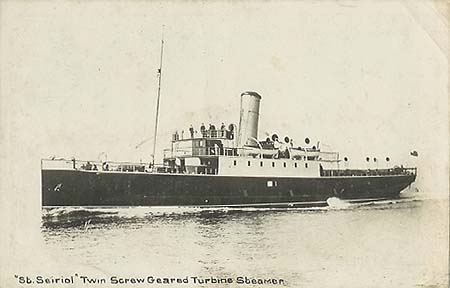
|
|
Sep 15, 1915
|
Disembarked in Boulogne,
France and the battalion proceeded to St. Omer
|
|
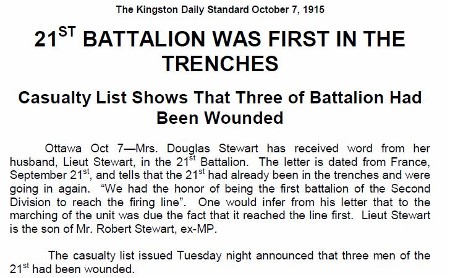
|
|
Oct 26, 1915
|
Proceeded to the Trench
Warfare School
|
|
Jan 16, 1916
|
Admitted to the No. 5 CFA
(Canadian Field Ambulance) with a diagnosis that reads Mumps
Transferred the same day to
the isolation hospital in Bailleul, France
|
|
Jan 17, 1916
|
Transferred to the No. 7
General Hospital in St. Omer
|
|
Feb 7, 1916
|
Discharged to duty from
hospital
Proceeded to England and
transferred to Division Headquarters in Bramshott to be Orderly Officer to
Brigadier General Lord Brooke
|
|
May 16, 1916
|
Transferred to the General
List of Officers and attached to the CAPC (Canadian Army Pay Corps) and
posted to the Pay and Records Office, London
|
|
Aug 2, 1916
|
Medical Board in London notes
Ø Suffers from
Cystitis, a bladder inflammation
Ø He is unfit for
active service
Ø Brought on by
exposure in the trenches
Ø Will be unfit for
at least 2 months
2 months later the same board
recommended another 3 months away from the trenches
|
|
Dec 1, 1916
|
Attached to No. 1 Detachment
Headquarters, CAPC
|
|
Jan 15, 1917
|
Ceased to be attached and is
transferred to the Canadian Army Pay Corps from the General List
|
|
Aug 2, 1917
|
Admitted to the 2nd
London General Hospital, St. Mark’s College, Chelsea with a diagnosis that
reads Renal Calculus (kidney stones)
|
|
Sep 7, 1917
|
Transferred to the Queen
Alexandra Military Hospital, Millbank
|
|
Sep 19, 1917
|
Surgery performed to remove 3
kidney stones
|
|
Oct 1, 1917
|
Appointed to the rank of
Temporary Captain
|
|
Oct 19, 1917
|
Medical Board in London
recommends that he be invalided to Canada
|
|
Oct 24, 1917
|
Discharged to duty from
hospital and granted sick leave until November 17, 1917
|
|
Nov 17, 1917
|
Embarked the SS Tunisian in
Liverpool and invalided to Canada
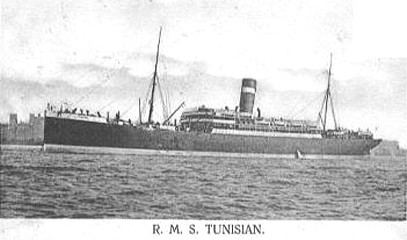
He was appointed to be
Paymaster while onboard the troop ship
|
|
Dec 1, 1917
|
Disembarked in Saint John, New
Brunswick and proceeded to Ottawa
|
|
Dec 20, 1917
|
Medical Board in Ottawa
recommends that he be observed for 1 month while receiving treatment for
Cystitis
|
|
Jan 28, 1918
|
Medical Board in Ottawa
recommends that he perform light duties only
|
|
Jun 19, 1918
|
Appointed to be the Temporary
Quartermaster of the Gymnastics School, Ottawa, Ontario
|
|
Sep 25, 1918
|
Appointed to be Paymaster of
the 2nd Depot Battalion, Eastern Ontario Regiment, Ottawa
|
|
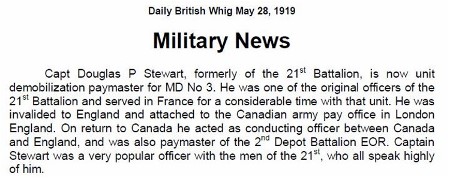
|
|
Jun 30, 1920
|
Medical Board in Kingston,
Ontario notes
Ø Man complains of
spots in his eyes, sciatica in both legs, pain in lumbar region and both
ankles swell on standing
Ø Is puffy under both
eyes
Ø Fatty nodules on
left arm, left buttock and both legs
Ø Urine has pus cells
Ø Patient is somewhat
nervous
Ø Patient claims that
he had no symptoms prior to enlistment
Ø Board recommends
that he be discharged from the CEF as Medically Unfit for General Service
Ø To be sent to the
SCR (Soldier’s Civil Re-establishment) for further treatment
Discharged from the CEF in
Kingston
Following his discharge, the
1914-15 Star, British War Medal and Victory Medals were sent to him c/o the
Halifax Hotel, Halifax, Nova Scotia
Following his discharge, he
lived in California, USA for a while before returning to Vancouver because of
illness. While in Vancouver he had his
right leg amputated. He later moved to
Kingston.
|
|
Jun 15, 1946
|
Douglas Paterson Stewart died
while a patient in the Veteran’s Hospital, Kingston, Ontario of Bilateral
Pyelonephritis (a kidney infection) and was buried in the Beechwood Cemetery,
Ottawa, Ontario
|
|
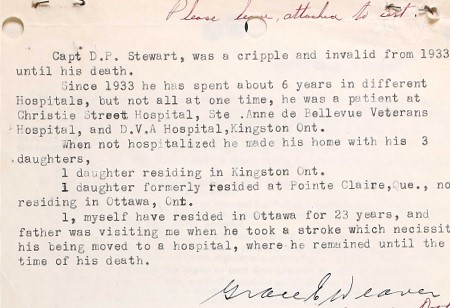

His death was ruled to be a
result of his active service, however no Memorial Cross was issued as both
his wife and mother had pre-deceased him
|
|

